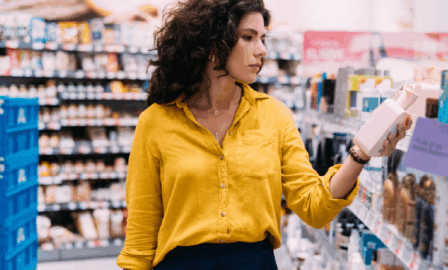Understanding the Challenges of Personalization in Health and Beauty
Despite economic uncertainty and rising inflation, the health and beauty industry has continued to grow over the past several years. The pandemic pushed the industry out of its comfort zone by forcing companies to enable more direct-to-consumer and online channels for selling, replacing the traditional makeup counter experience. What started as an innovative concept prior to 2020 is now the expectation from consumers. Trailing the broader CPG industry demand for personalized products, consumers are increasingly seeking personalization in health and beauty for their own personal care products.
With the growth in DTC capabilities within health and beauty, companies are more easily able to sell personalized products to their consumers. As the industry adapts, innovates, and grows, companies are faced with the challenges of the level of personalization in products and the manufacturing and distribution complexity that come along with more individualized products.
The Shift to DTC
Cosmetics and beauty product sales have historically been driven by in-person shopping, where consumers can try on, touch, smell, and experience products. The pandemic, in part, forced consumers to become more comfortable with DTC purchases, whether they were staying brand loyal or purchasing new products.
The rise in social selling and influencing helped fill the gap of the in-store experience, where consumers could see and experience social influencers using products and thus feel more comfortable purchasing that same product. Additionally, with the rise of digitally native health and beauty companies, competitors were forced to expand their online capabilities, including artificial intelligence (AI), like shade matching, to increase consumer confidence when purchasing.
Without the restrictions of shelf space, companies can offer a wider range of products and can more easily personalize products for consumers than a traditional in-store experience, which offers a product selection that appeals to as many consumers as possible.
Further, with an increase in DTC sales, innovative companies are developing formulations to best suit consumers’ needs and causing disruption to traditional manufacturers who need to determine what degree of personalization is best to resonate with their target consumer. The level of personalization varies by company but can be difficult to execute. Because the pandemic accelerated consumer trends in the health and beauty space, companies are now grappling with the complexities to be able to support this personalization through technology and complex distribution.
Degrees of Personalization
The global skincare industry is valued at nearly $100 billion and growing because of an increased consumer focus on health and beauty as well as the broad range of skin types, needs, and treatments. As the health and beauty industry focuses more on inclusivity, the market will continue to grow. Within the industry, the definition and degree of personalization vary by company and their go-to-market approach.
The easiest degree of personalization is for companies to implement online questionaries for consumers. Based on the answers, a company can make product recommendations suited to the consumer’s need while pulling from their existing product line. As companies are increasing their DTC sales and trying to deepen connections with their consumers, these online personalization activities will become the expectation. Companies are using AI and other technologies to be able to make personalized product recommendations and conduct shade matching, creating a more intimate and specialized online shopping experience.
The highest degree of personalization is with companies that specifically formulate products for consumers to help address needs. Companies like Function of Beauty and Proven are changing the way consumers think about their products, how they are made, and how they suit specific requirements. However, this can be difficult to scale, and therefore, they still sell off-the-shelf products.
For companies with standard product lines looking to strengthen consumer loyalty and build a personalized shopping experience online, the key to creating online assessments is to have the results funnel to their existing product line. Consumers feel a deeper connection to the brand because of the specific recommendations, and the manufacturer maintains its existing product line.
Personalization is becoming more readily available in health and beauty, vitamins, and other markets.As such, companies are investing in processes and technology to support different degrees of personalization because consumers who feel their product is tailored to their needs are willing to pay higher prices.
Complexities of Personalization in Health and Beauty
While some companies provide unique formulations for consumers, most are using lighter degrees of personalization. Custom order fulfilment creates complexities in manufacturing and distribution that make it difficult to scale. Between longer lead times for manufacturing and less economies of scale, companies like Function of Beauty also sell mass-market products to retailers.
For brands looking to provide higher degrees of personalization in their products, there are a few considerations to keep in mind:
- Time: Consumers want personalized products, but they don’t necessarily want to wait long for them to arrive. The costs of manufacturing and distributing individualized products in a timely manner to meet consumers’ needs can be costly. Using local vendors or implementing new technologies can be a viable option to save costs and time.
- Manufacturing: Companies have become accustomed to mass producing their products in large volumes and sending to one central location; now, there’s a need to produce products in smaller quantities and distribute them to individual customers. The logistics of manufacturing and distribution of personalized products cannot be overlooked.
- Supply chains: Most companies work with a single supply chain for mass production; however, with personalized beauty products for unique customers, businesses should be operating with separate supply chains that offer flexibility to cater to different demand patterns. This will also mean establishing and maintaining strong supplier relationships. While cost- and time-intensive in the short term, separate supply chains can reduce lead times and waste reduction in the long term.
Counterbalancing truly personalized products with a stable product line allows the company to scale and grow while also providing a deeper connection to consumers through personalized products. Finding the right balance of personalization within products and company strategy is key for companies to ensure success and not overburdening themselves with process and procedure.
If you’re looking for a trusted advisor to help navigate hyper-personalization in health and beauty, contact our team today.
Subscribe to Clarkston's Insights
Contributions by Jake Park-Walters



